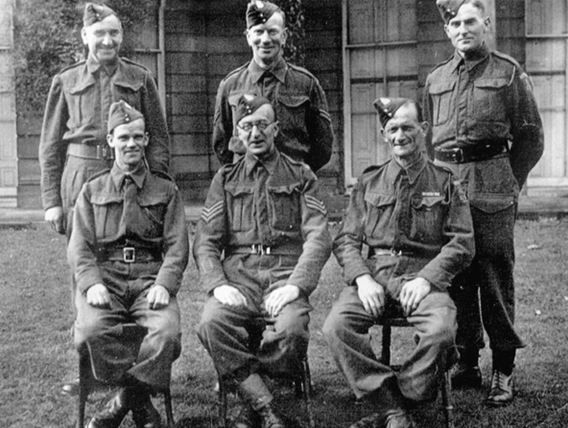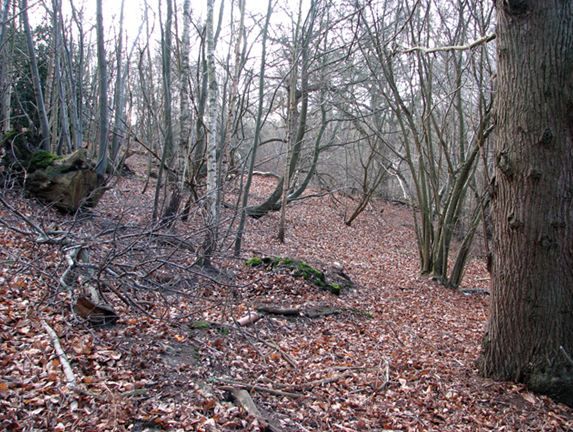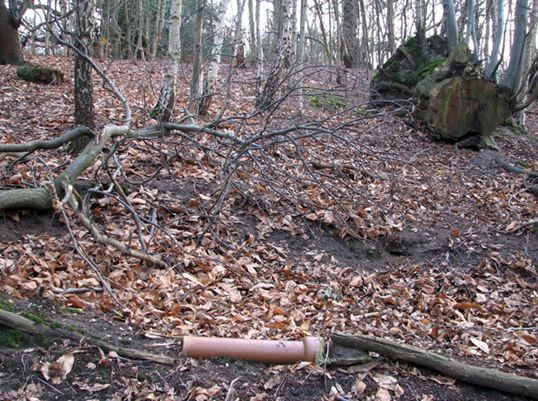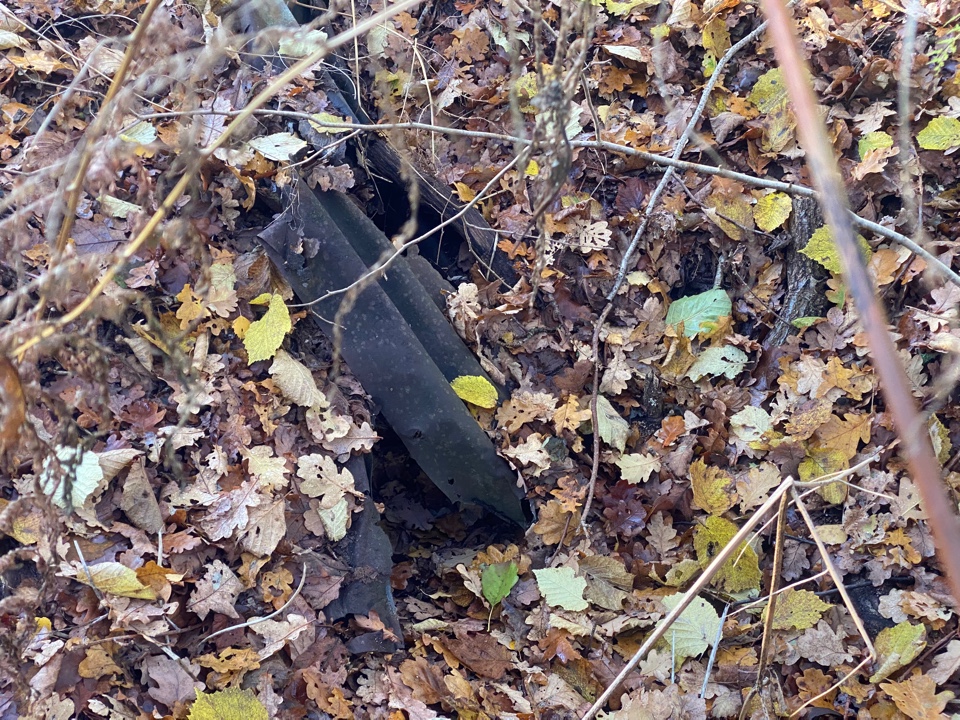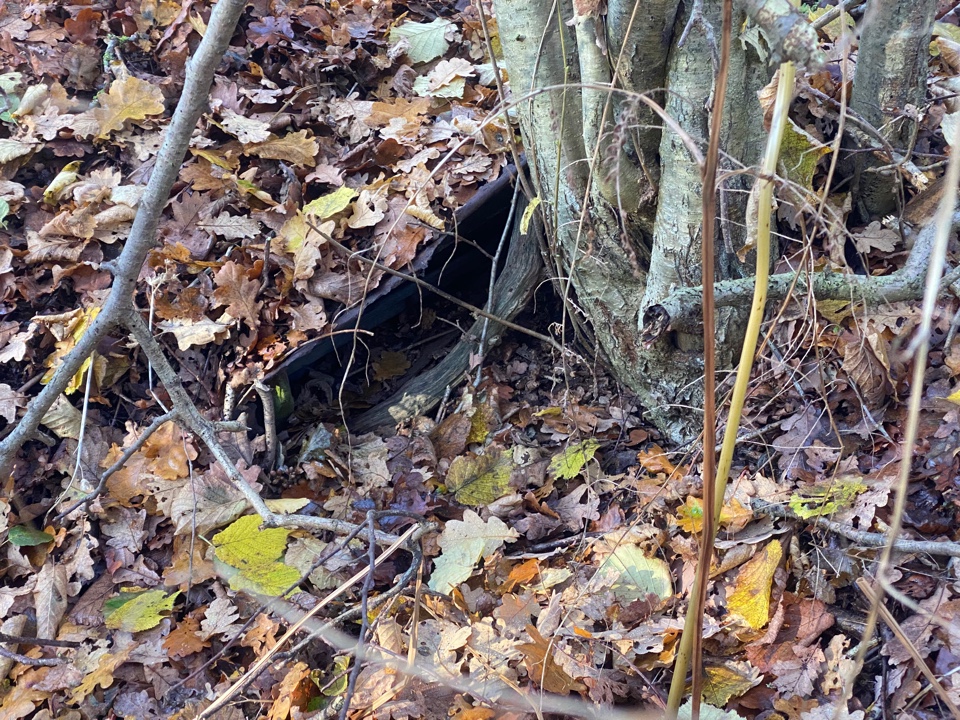East Bergholt village is 3 miles north-east of Manningtree.
| Name | Occupation | Posted from | Until |
|---|---|---|---|
| Sergeant Noel Reginald Devonshire | Factory worker |
Unknown | 03 Dec 1944 |
| Corporal Raymond Percy Abbott | Painter and decorator |
Unknown | April 1943 |
| Private Charles Reginald Ambrose | Factory worker |
Unknown | 03 Dec 1944 |
| Private Charles Goodchild | Small holder |
Unknown | 03 Dec 1944 |
| Private William Warden Miller | Farmer |
Unknown | 03 Dec 1944 |
| Private Geoffrey Bernard Ratcliffe | Electrical engineer apprentice |
Unknown | Unknown |
| Private William Merton Smith | Film casting and photographer |
Unknown | 03 Dec 1944 |
The OB was located in woodland known as The Commons, about 15 metres to the west of Dead Lane, a cart track that is currently a well-used public footpath. The Commons is situated west of East Bergholt and bordered by the A12 road in the north.
Only a rectangular depression and a lengths of a glazed field pipe remain of the Patrol’s OB.
According to the information lodged at B.R.O.M at Parham, dating from 1996, the OB was a flattop construction. At some time in the past the roof was removed and the structure was filled in, with metal side sheets still in place and air pipe remains.
According to an account published in the newspapers (East Anglian Daily Times 20 Oct 2008), the structure measured 10 by 12 foot and the construction was of corrugated iron. The roof was corrugated iron resting on sections of disused Ipswich tram lines. This account gives an incorrect location for the OB site and cannot be verified.
The OB was built on a lightly wooded slope which, going by the ancient trees still in situ, would have been populated by sweet chestnut trees.
The site is located about 50 metres downhill from what in the 1940s would have been a cart track. An old gate and some weathered fence posts with adhering very corroded barbed wire fencing indicate that this section would once have been fenced off. Only a slight rectangular depression remains. We did not notice any corrugated sheeting but there is a length of glazed ceramic field pipe lying at its perimeter.
A later investigation by Gareth Evans considered the original location could be the other side of the bank around 65 steps away. Moving round the banks and having a good search round he found a large depression with a metal structure remains. It is thought over the years the pipe had been moved from its location.
East Bergholt Patrol
Targets would have included Raydon Aerodrome along with railway line and bridges in the vicinity.
The following information was taken from an article published in The Independent (Arts & Entertainment) on 26 September 1998 (author: John Morrish):
Geoff Ratcliffe was a founder member of the unit in East Bergholt, Suffolk, along with three farmers and a factory worker, whose occupations kept them out of the forces. All were members of the local Home Guard, and that would remain their cover.
Ratcliffe remembers being given only a vague idea of what was to come. He was shown the OB, a hut buried in the ground in a wood off the A12, where the Patrol would hide itself each weekend. At the organisation's headquarters at Coleshill, near Swindon, he was taught to destroy tanks with plastic explosive and "sticky bombs", which you "lobbed underarm" from close range.
He was given no illusions about his own chances in the event of an invasion. "We would have been found and exterminated, no doubt," he says. "There were no long-term career prospects."
The Memories of Auxilier Geoff Ratcliffe
I am writing this at the request of my daughter Jenny, to prevent the information getting lost in the sands of time. It is a subject that until recently, I have never mentioned to anyone within the family, not even my wife Shirley. Recently, quite by chance, I read an article in the Daily Telegraph about the Aux Units planning a reunion, 50 years after de-commissioning. I do not know what made me read on, but in a few seconds I saw that this was the organisation to which I belonged, when I was seventeen years of age. I wrote to the address given and today the 25th of October 1994 I attended that re-union.
In June 1940 I became a member of the Home Guard, L.D.V. (Local Defence Volunteer) as it was first called. Soon after I was selected for what was said to be a very special job, I do not know why me, to this very day. I was seventeen good at sport very much at home in the countryside and I had performed very well at the rifle buttes. This may all have had a bearing, or at least have been contributory factors, it is pure conjecture, I do not really know.
I found I was joining four others, three farmers and a factory worker all considerably older than me and to my seventeen year old mind well below my ability in speed and action. One of the farmers I knew well a Mr. Miller a Scotsman and a very pleasant man with a great sense of humour he was very mature and would be very steady in any crisis. He had been a great supporter of the football team I ran in the village.
The other two farmers I did not know personally, but I knew the location of their farms. They were both poultry farmers, one located in the Wenham Lane the first farm in the lane. The other on the Capel St. Mary side of Latinford Hill. The Wenham man was going to be the man in charge he was the eldest in the party and I believe had been in the army before. Unfortunately I cannot now remember his name. The other chicken farmer was a young man rather large and his name was Tricker, on my assessment he came low to middle in ability.
It was soon evident that the two chicken farmers were buddies, this was certainly confirmed when one was promoted from Sergeant to Captain and the other from Private to Lieutenant. Apart from quickly learning that ability was low in the list of requirements for promotion, this did not ever present a problem in the operation. In any case as far as I am aware the only reward was additional petrol coupons.
The factory worker was in his upper twenties or lower thirties a pleasant enough fellow in a steady sort of way, his name was Devonshire. A very mixed bunch, no obvious connections, for team making, except three were farmers, albeit diverse types of farmer. Today I think I found the connection after fifty four years, not that I have given it much thought during that time. The three farmers and the factory worker were in reserved occupations and I was a year under age, they had formed a team free from military call up. That is my theory after meeting the people today and seeing so many of them were farmers or agricultural workers. So much for my ego lasting 54 years that ability may have played a part in my selection. Oh well I will still let my ego tell me my present theory could be wrong.
Apart from being told we had been specially selected, true if my present theory is correct, one was left with the impression that we were really rather special, I was seventeen and cynicism was not in my vocabulary. I hope it still isn’t, but I have gained shall we say in worldly wisdom.
It was a dangerous mission, we were expendable, specially selected, would be specially trained and it was top secret. How can you possibly turn down a mission like that? Dunkirk had just unfolded and we were about to be invaded by the Germans. Yes I was in, whatever it was.
The five of us were to be trained in guerrilla warfare and to have a hide out in the village of East Bergholt. In the event of the country being invaded and overrun by the Germans, we could operate as guerrillas and continue the war against the invaders. As time was of the essence, events moved fast and we quickly selected a spot for our hideout, in a wood about a quarter of a mile from the Al2 and 50 yards from the nearest footpath which in any event was infrequently used.
I was familiar with this area like the back of my hand. The woods had bluebells, lily of the valley and chestnuts which were Sunday afternoon attractions in their particular seasons. The woods were owned by the Hughes family. Sir Collingwood Hughes had died in the thirties and his daughter who was married to Admiral Wake Walker was the owner at that time.
The sub soil was golden sand free from water in fact nearby were disused sand pits, a much explored area by we boys in the school holidays and on our Sunday afternoon walks. The ground sloped away to a free flowing stream some fifty yards away. This would be our water provider, in 1940 this water could be safely drunk.
A large hole was dug and a sectioned hut-like structure erected in the hole with a trapdoor entrance down a vertical ladder. The excavated hole was filled in and the surplus sand distributed. Later much more consideration was given to providing an anti-grenade trap at the bottom of the ladder to prevent the Germans from lobbing a grenade into our home. Later still some hide outs were provided with a back entrance. The theory being to exit from one door while the Germans were entering the other.
We were still concerned that the newly disturbed soil made the area conspicuous, the golden sand in particular gleamed through the trees, it seemed like a beacon. Within a very short period the abundance of leaf mould and the rapid growth of ferns and the undergrowth completely camouflaged the area and we began to need special markers ourselves to find the entrance to the trapdoor.
The structure was provided by the regular army and delivered to the site. I seem to remember we actually dug the hole and erected the hideout. I found out at the reunion that later models were made of concrete and steel and erected by the Pioneer Corps. I can only assume as we were on the East coast we were the first to be established and that speed was the first priority.
The hideout could accommodate six but in my term of service we were only five. At the reunion they seem to have varied between five and eight, but only six operative at anyone time.
As far as I am aware I am the only survivor of the five from East Bergholt original team, there may be some who joined later.
I do not know if the hideout was ever removed and although I have since walked along the path 50 yards away I have never been back to the actual spot. I expect it was removed by the squad when they disbanded in 1944.
Some of the Units appeared with up to three survivors at the reunion but these appeared to be from villages where the people had remained in the village all their lives and thus able to keep in contact. I naturally tried to find all the representatives from Suffolk. At the reunion I found three from Stratford St. Andrew and one from Brandon.
The officer responsible for setting up the Essex and Suffolk Units was there, Colonel Cox, he remembered East Bergholt but I found him rather difficult to communicate with he was deaf and must have been well into his eighties.
Our training for Guerrilla warfare started and went on apace. We were issued with an old Browning automatic rifle to start with. This was a 0.300 calibre rifle and had a magazine of 20 which could be fired as single shots or in bursts. This was an old 1914 war, vintage, American weapon, heavy and accurate, in fact as accurate as a rifle at least on single shot. I preferred to use it that way because it did away with the bolt action of the ordinary rifle and in the burst mode only the first shot would be accurate. The burst mode could be used against groups of people and it gave the impression that a machine gun was being fired.
This was supplemented later with a Tommy gun a fearsome highly inaccurate heavy calibre 0.45 machine weapon fired with a circular drum magazine containing 50 rounds. It often jammed, you didn't aim but merely pointed and let fly a burst. The heavy recoil of the 0.45 calibre ammunition made the gun difficult to hold in any accurate pattern it was strictly a spray machine. Of American gangster fame it did enormous damage if you hit anything with it, strictly a short range weapon and heavy to carry. I suppose the case was somewhat shaped like the famous violin case portrayed in the gangster films. The circular magazine drum made this shape necessary. We also had a German Mauser machine pistol beautifully made and accurate.
Later Sten guns were issued, the early version of these were temperamental, light on the trigger, fired if dropped and could quickly run away with you, as could the Thompson machine gun. Also very easy to shoot your toes off, our Captain went close, and I always stood well back when he fired on the practice range, the gun had to be respected. They were a low cost simple machine designed to be produced quickly and to fire a variety of ammunition including 9 mm shells. Far lighter than the Thompson gun and used in much the same way. It became a popular general purpose gun in the British Army. Later versions were made much safer to handle and the gun more accurate. For our own personal side arms we were issued with Smith and Wesson revolvers of 0.38 calibre reasonably light and easy to use. I practised a lot with mine in the garden at the back against Dad who used his 0.45 Webley he had illegally kept since the first world war. The ammunition from the Thompson fitted that, this allowed me to become reasonably efficient without reaching quite the standard of Wild Bill Hickok. One of the neighbours complained to the local village Bobby about our garden practice. By then Dad had given his revolver to Bill Rayner who was a Captain in the Brantham Home Guard, and I was perfectly entitled to use mine so the nasty little man in both stature and spirit, was thwarted.
I vowed to point out his house to the Germans if they came rather than try to defend it. The practicality of actually how to do that did not go through my mind. In any case he was obviously the type who would defect to the Germans should they have ever appeared.
We were given standard hand grenades and taught to prime them and how to throw them. High trajectory for two reasons, to prevent them rolling when landing and to allow the 4 second fuse to use most of its time before landing otherwise they can be picked up quickly and thrown back. The fuse time had already been reduced from 7 to 4 seconds. Again I spent a lot of time in the garden at home and eventually was able to drop a dummy grenade on a spot of dinner plate size 8 times out of 10. My cricket experience was a great help because grenades are thrown with an overhead lob. We were also issued with sticky bombs. These were made of fairly large glass circular bulbs filled with a liquid high explosive I believe nitro glycerine and mounted on a hollow wooden handle.
The bomb would be primed by inserting a detonator into the hollow handle. The whole glass bowl was covered with a sticky mess of muslin and birdlime. A metal cover which was in two halves and spring loaded to spring apart when a pin was pulled just before you wanted to use or throw the bomb, covered the complete glass bowl. The bomb was lobbed underhand on to a passing tank or vehicle not overarm in case it stuck to your back. The detonator operated in much the same way as the hand grenade, pull the pin and the handle released when you let go of it activating what I believe was a 10 second fuse. The additional time was to allow sufficient time to allow the tank or vehicle to pass out of danger before it exploded or if the vehicle was stationary to allow sufficient time to escape. The explosive in the thin glass bowl although liquid would be contained in the sticky mass when the glass bowl broke on landing on the tank or vehicle.
Much more powerful than the grenade it caused a big bang, they were scarce so we did not have too many to practice with and handling them in the dark was never comfortable.
The main part of our armoury consisted of a good supply of plastic explosive, fuses and detonators. The plastic explosive was packed exactly like children's Plasticine and just as easy to handle at least in the un-primed state. It could be moulded or wrapped around a magnet and it was a very powerful high explosive equivalent to or more powerful than T.N.T. and made by I.C.I. Today the modern version, we call Semtex.
Many of the techniques of guerrilla warfare were devised by the Finn's and had been used in the Russian / Finnish war of the thirties. One such technique was to stick on the underside of a tank a magnet wrapped in plastic explosive either when the tank was parked or when the tank was passing over them in the trenches. The underside of a tank is the most lightly armoured part of the tank and therefore the most vulnerable.
The explosives stock included three types of fuse. Coils of slow burning fuse wire looked exactly like lengths of electric cable. The core was filled with a slow burning explosive which could be ignited with a match or the end of cigarette and burned slowly much like a firework. The time was controlled by the length of the coil, calculate your time, cut your length and you were in business. There were two types of core cable fuse with two distinct burning times and the cables distinguished by colour code. A third cable in the armoury was a high explosive cable burning at the rate of 22 metres a second which really means a bang. This was also used as a means of detonating the plastic explosive. Tie a knot in the cable, wrap plastic explosive around it, crimp a mercury fulminate detonator to the other end and you had a device bomb.
The bomb together with the fuse cable could be hidden in the road, run the cable explosive taken to the other side of the hedge and the device triggered from the ditch and get instant results.
The small silver coloured slim pencil shaped mercury fulminate detonators were the most delicate and dangerous to handle. One variety had an electrical element built in to be used to fire a bomb electrically. Drop them, bend them, or over heat them and they could explode. They were powerful enough to blow off fingers, burst eardrums and blind you. If they went of when you were priming plastic explosive or a hand grenade or a sticky bomb then of course the whole lot went including you.
Some people never did get comfortable in handling them. They were kept in a special box and stored where they could not be kicked or dropped. They were also used in conjunction with a percussion device of which we had four types. Each type had a striker spring held in tension by a wire.
A trip wire made of piano or snare wire could be used to operate the spring. The spring would carry the striker onto the detonator which was crimped to the device and explode the detonator. The other three mechanisms were activated by crushing a glass file. The striker spring was held in tension by a copper wire anchored by passing it through a thin copper tube which contained a small phial of acid. To activate the device, the copper tube was crushed between finger and thumb, which broke the thin glass phial which in turn released the acid into the copper tube and around the copper wire holding the striker in tension. According to the thickness of the wire so the time for the acid to eat through the wire was calculated. We had thirty minute, three hour and six hour devices. Naturally using the acid method they were not accurate to the minute.
To attack tanks or vehicles at night, bombs would be made up of plastic explosive wrapped around magnets. The faces of the magnets must be left clean to allow a good clamp to the target. A mercury fulminate fuse would be inserted into the plastic explosive by making a hole with a pencil and inserting the fuse and moulding the plastic around it. The detonator would have already have been crimped to the acid activating device.
Leave the hideout at night seek out the parked tank or vehicle attach the magnet to the underbelly, tracks or fuel tank of the vehicle crush the copper tube and get away. The three hour devices were the most popular in case you had to remain in cover for some time. We practised this a good deal without actually priming the detonators. Supplies were hard to come by.
Piano wire to stretch across the road in order to decapitate German motorcyclists was another part of the weaponry. All in all we were well equipped but no mention how stocks would be replenished if it ever happened. I suppose it was assumed one would not last longer than the supplies.
In addition to the weaponry we were also stocked up with tinned and dried food. The whole armoury and all the food stocks were stored in the hideout.
Why have the reunion in a little village in Wiltshire. The Headquarters of the organisation was centred at Coleshill House in the village of Coleshill is the simple answer. The house was both the headquarters and the training centre for the Auxiliary Units. A small staff of regular soldiers organised the units and undertook the training. Unfortunately the house, which is now owned by the National Trust was destroyed by fire in 1956. The stable block is still intact and the foundations of the original house have been laid out in their original outline. It was pleasant mainly because it was such a beautiful sunny day to walk around the grounds after lunch at the village school.
I remembered very little except the stable block which has a clock tower and where we were billeted when we went for our period of training.
All our exercises were by necessity carried out at night without the chance of daytime reconnaissance. The surrounding fields paths and grounds had not previously been explored by us before. We had all met at the Radnor Arms Pub at twelve noon, sixty five of us, that was the ticket limit to be able to sit down for lunch at the small village school. All obviously of mature age. I hunted around for Suffolk representatives and found four. Three of them from one spot. The nearest one I found to East Bergholt was from Brightlingsea which is in Essex. I sat on a table with three of the Suffolk men and three from Driffield in Yorkshire. They all still lived exactly where they did in 1940 and were all farmers.
I was very much entertained by the conversation throughout the lunch. Their views on many issues of today, the Social Services (too many scroungers) took a hammering, among many other things. It was better than having a cabaret.
One of the Yorkshire members showed me a menu from their winding up dinner in 1944. Soup Miltaire, Rabbit Pie and Sultana Pudding, I asked him where on earth they had obtained the Sultanas from. He gave a knowing nod and obviously that information about the Aux. Units, is going to remain a secret for evermore !
The menu had a number of toasts and quotations in masonic style. We toasted the Queen and the Queen Mother and of course absent friends. A letter from the Queen Mother was read out, an atmosphere existed hard to describe but which developed naturally and took one back fifty years, undoubtedly a different era, we could do with some of those standards today. I am not a great re-unionist but I thoroughly enjoyed the lunch and the company.
A few mementos were brought to the re-union and a representative from the Imperial War Museum asked if he could have them to set up an exhibition.
The Secret Army never went to war, thank goodness. How we would have performed, I do not know. The lasting impression from the reunion was they would have liked an opportunity to have been tested, in some form or another. For myself I went off to join the R.A.F.
Yes I have been to another reunion, this time at The Bell, Rettendon near Chelmsford organised by Bert Cocks of Brightlingsea. He told me on the phone he was ninety he didn't sound like it and he certainly didn't look like it when I met him. There were twenty one of us and not surprisingly I didn't know any of them. I sat with three of them from the Signals Unit a Branch I knew nothing about.
They were in the regular army and set up a secret communication system for the auxiliary units from Scotland to Lands End. One of the Headquarters points apparently was Winchester. I found their stories very interesting including being found in woods by courting couples and being reported as spies and fifth columnists. One of them is still very much an Amateur H.A.M. and talks all the night to people all over the world on short wave mostly in Morse Code. Bert had stories to tell about the local area and I suppose the Dad's Army programme is so popular because there is a grain of authenticity within it.
An exhibition is being arranged in the Imperial War Museum to commemorate the Secret Army it will be opened in July.
Geoff Ratcliffe 1994
Accessed with kind permission of Dr W Ward
TNA ref WO199/3389
Hancock data held at B.R.A
1939 Register
Evelyn Simak and Adrian Pye
Gareath Evans
B.R.O.M at Parham,
DoB Dr Will Ward, Stephen Lewins; John Morrish (in: The Independent, 26 Sept 1998)
Geoff Ratcliffe
